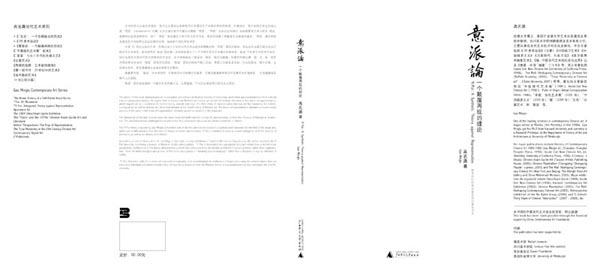|
Yi Pai: A synthetic Theory against Representation |

Gao Minglu
TABLE OF CONTENTS
Introduction
Chapter 1 Yi Pai is not a Theory about Abstraction
1. Abstraction is the Product of Western Modernism
2. The Contradiction of Western Representational Theory
Chapter 2 Yi Pai is not a Theory about Representation
1. The Principle of Yi Pai
2. Yi Pai: a Theory about Synthesis
3. The View at Thing: Comparison with Minimalism and Mono-ha
Chapter 3 Yi Pai and Semiotics
1. Li, Shi, Xing vs. Icon, Sign, and Symbol
2. Yi Pai:Making a Departure from Symbol Model
Chapter 4 Contemplation and Note on Yi Pai
1. Abstract, Conceptual and Realistic as the Pattern of Metaphysics
2. Heidegger’s Three Worlds and Li, shi, Xing
3. Synthesis is Nothing to Do with Wholeness
Li, Shi, Xing and Rituality
The author of this book demonstrates an investigation and critique of Western theories of classicism, modernism and postmodernism from a broad view of comparative studies. He argues that no theory from Western art history can be defined without reference to the notion of representation, which regards art as a substitute for human reality, concept and logic. It is this notion of representation that has set the foundation for realism, conceptual art as well as abstract art, three vital domains in the recent history of Western art. The theory of representation attempts to reveal certain portions of the world in terms of fragmentation, extremity as well as isolation in the visual arts.
The Chinese art of the last hundred years has never detached itself from the concept of representation, or from the influence of Marxism or modernism. This phenomenon has challenged the establishment of a constructive discourse for Chinese modernity or culture.
The Yi Pai theory proposed by Gao Minglu is therefore one of the first attempts to establish a sophisticated framework for the field of the visual arts, which can be differentiated from Western art theory rooted in representation. Yi Pai is intended to serve as a methodology for both the practice of art-making as well as art history and criticism.
Inspired by an ancient theory of Li, Shi and Xing, or “principle, concept and likeness” from the 9th century Tang Dynasty, the author constructs his Yi Pai theory by combining a number of Western modern philosophies. Yi Pai is formulated in a pluralized structure rather than a dichotomous perspective. Furthermore, Yi Pai theory demonstrates a world view continuous from the ancient period which valued synthesis rather than fragmentation. From the methodological perspective, Yi Pai favors yizai yanwai or “meaning beyond language” rather than a dogmatic or logical reflection of reality.
Yi Pai, therefore, calls for a return of originality in humanity, a re-establishment of intellectual critique advocating cultural values that can transcend individual and environmental limits, in hope for a departure from the Western theory of representation that has dominated the field for centuries.
|
|
|
 |
Exhibition |
|
 |
Archive |
|
|
 |
Project |
|
|
 |
 |
|
|
|

